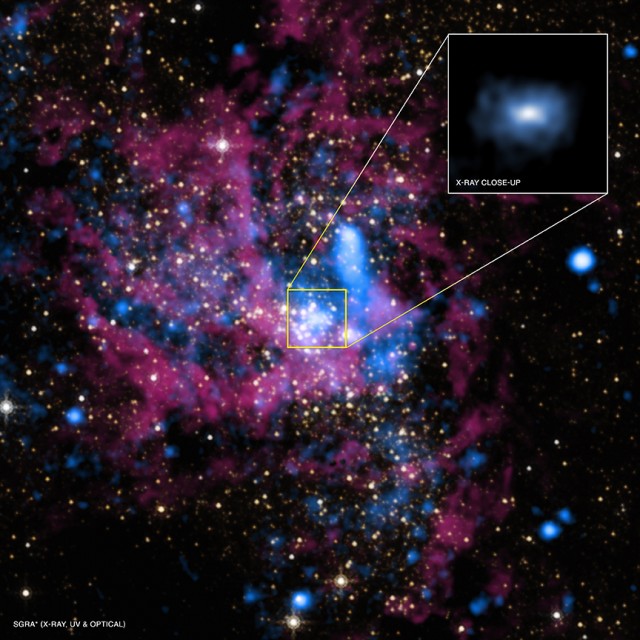
Multiwavelength view of the central region of the Milky Way, including the black hole (also known as Sagittarius A*). The inset is a new X-ray observation, which shows the details of the accretion disk around the black hole. The purple and yellow are infrared emission, while the blue is X-ray light.
X-ray: NASA/UMass/Q.D. Wang et al.; IR: NASA/STScI
X-ray observations show why Sagittarius A* is fainter than many galactic nuclei
Despite the common conception that they suck down everything that passes nearby, black holes are messy eaters. Gas swirls around them due to the strong gravitational field, but much of the material is blasted back into the surrounding galaxy. In many galaxies, that messiness makes the black hole extremely bright, but the Milky Way's supermassive black hole devours material so inefficiently that it's actually one of the quieter galactic nuclei around.
A high-resolution measurement of X-ray emissions near the galactic center shows the structure and feeding of the Milky Way's monster in new detail. Q. D. Wang and colleagues determined the light it does produce comes from a very compact region right near the galactic center. That supports the hypothesis that X-ray emissions are due to black hole accretion—mass falling into orbit around it. They also determined that no more than one percent of all the accreted matter ever crosses the black hole's event horizon.
The existence of the Milky Way's black hole is uncontroversial. The motion of nearby stars and the behavior of the local gas reveal the presence of a compact, massive object. Its mass is roughly four million times that of the Sun and its radius is smaller than the Solar System, which rules out nearly every alternative explanation.
However, some aspects of the black hole's behavior were harder to determine. The radio source at the Milky Way's center, known as Sagittarius A* (or Sgr A*, with the "*" pronounced as "star"), is much fainter than many galactic nuclei. Even assuming the black hole is feeding slowly compared to the maximum possible rate, theoretical models predict it should be brighter by a factor of 100 million. The general consensus is that Sgr A* is feeding in a particularly inefficient way, spewing more matter back into space than falls in.
There's a big challenge to testing this hypothesis: the region between Earth and the galactic center contains a lot of dust, which blocks visible light. Infrared and radio waves both pierce that dust, but their long wavelengths require correspondingly large telescopes to achieve high resolution. That places fundamental limits on how closely the light emissions can be pinpointed relative to the black hole. After all, astronomers are trying to study a region smaller than the Solar System at a distance of 26,000 light years.
The new observations used the orbiting Chandra telescope, which captures small-wavelength X-ray light. The researchers were able to resolve the region sufficiently close to the so-called Bondi radius, where material is more likely to fall into the black hole. They found the X-ray emissions were extended in an elongated structure on either side of the black hole, consistent with an accretion disk: matter rapidly orbiting around Sgr A*.
The astronomers could also rule out the hypothesis that the X-ray and radio emissions from this area came from stars since it lacked the expected spectral lines from iron and potassium. Additionally, they determined the emission had no appreciable fluctuations, as would be expected from flares or other stellar phenomena.
Everything they observed was completely consistent with extremely inefficient light emission from matter swirling around Sgr A*. Based on their observations, the researchers concluded that no more than one percent of the matter in the accretion region actually passed the black hole's event horizon. The rest is ejected back into the galaxy, where it contributes to the diffuse light emission in infrared and radio. That's a Cookie Monster approach to eating, but it ends up explaining why the Milky Way's black hole is so faint.
Science, 2013.
No comments:
Post a Comment